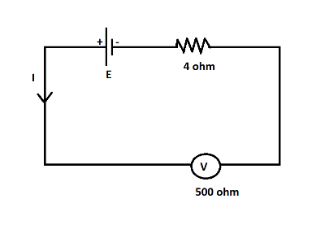
A voltmeter with resistance $500\Omega $ is used to measure the emf of a cell of internal resistance $4\Omega $ the percentage error in the reading of the voltmeter will be
A. 0.2%
B. 0.8%
C. 1.4%
D. 2.2%
Answer
577.8k+ views
Hint: To solve this question, we have to remember that, I drawn from the cell having emf E and external resistance R and internal resistance r can be given as: $I = \dfrac{E}{{R + r}}$
Complete answer:
Given that,
Resistance of the voltmeter, R = $500\Omega $
Internal resistance of the cell, r = $4\Omega $
We know that a voltmeter is used to measure the potential difference in a circuit.
So, the actual value for which the voltmeter is connected to measure = E.
Now we have to find the measure value of potential difference by the voltmeter.
We know that,
$I = \dfrac{E}{{R + r}}$
Putting the given values, we will get
$
\Rightarrow I = \dfrac{E}{{500 + 4}}A \\
\Rightarrow I = \dfrac{E}{{504}}A \\
$
Now,
Potential difference, V = IR
$
\Rightarrow V = \dfrac{E}{{504}} \times 500 \\
\Rightarrow V = \dfrac{{500E}}{{504}} \\
$
So, we can say the measure value of the potential difference by the voltmeter is $\dfrac{{500E}}{{504}}$ Volts.

We know that,
Error = actual value – measured value
Therefore,
Error = $E - \dfrac{{500E}}{{504}}$
Error = $\dfrac{{504E - 500E}}{{504}}$
Error = $\dfrac{{4E}}{{504}}$
Now, we have to find out the % error
Hence,
% error = $\dfrac{{{\text{error}}}}{{{\text{actual value}}}} \times 100$
Putting all the values, we will get
% error = $\dfrac{{\dfrac{{4E}}{{504}}}}{E} \times 100$
% error = $\dfrac{{400}}{{504}}$
% error = 0.8%
Hence, we can say that the percentage error in the reading of the voltmeter is 0.8%
So, the correct answer is “Option B”.
Note:
Whenever one asks such types of questions, first we have to identify the combination of the resistance, either they would be in series combination or parallel combination. In parallel combination, the potential difference across all of them is the same and current through any resistor is inversely proportional to its resistance.
Complete answer:
Given that,
Resistance of the voltmeter, R = $500\Omega $
Internal resistance of the cell, r = $4\Omega $
We know that a voltmeter is used to measure the potential difference in a circuit.
So, the actual value for which the voltmeter is connected to measure = E.
Now we have to find the measure value of potential difference by the voltmeter.
We know that,
$I = \dfrac{E}{{R + r}}$
Putting the given values, we will get
$
\Rightarrow I = \dfrac{E}{{500 + 4}}A \\
\Rightarrow I = \dfrac{E}{{504}}A \\
$
Now,
Potential difference, V = IR
$
\Rightarrow V = \dfrac{E}{{504}} \times 500 \\
\Rightarrow V = \dfrac{{500E}}{{504}} \\
$
So, we can say the measure value of the potential difference by the voltmeter is $\dfrac{{500E}}{{504}}$ Volts.

We know that,
Error = actual value – measured value
Therefore,
Error = $E - \dfrac{{500E}}{{504}}$
Error = $\dfrac{{504E - 500E}}{{504}}$
Error = $\dfrac{{4E}}{{504}}$
Now, we have to find out the % error
Hence,
% error = $\dfrac{{{\text{error}}}}{{{\text{actual value}}}} \times 100$
Putting all the values, we will get
% error = $\dfrac{{\dfrac{{4E}}{{504}}}}{E} \times 100$
% error = $\dfrac{{400}}{{504}}$
% error = 0.8%
Hence, we can say that the percentage error in the reading of the voltmeter is 0.8%
So, the correct answer is “Option B”.
Note:
Whenever one asks such types of questions, first we have to identify the combination of the resistance, either they would be in series combination or parallel combination. In parallel combination, the potential difference across all of them is the same and current through any resistor is inversely proportional to its resistance.
Recently Updated Pages
Master Class 12 Business Studies: Engaging Questions & Answers for Success

Master Class 12 Economics: Engaging Questions & Answers for Success

Master Class 12 English: Engaging Questions & Answers for Success

Master Class 12 Maths: Engaging Questions & Answers for Success

Master Class 12 Social Science: Engaging Questions & Answers for Success

Master Class 12 Chemistry: Engaging Questions & Answers for Success

Trending doubts
What are the major means of transport Explain each class 12 social science CBSE

Which are the Top 10 Largest Countries of the World?

Draw a labelled sketch of the human eye class 12 physics CBSE

Explain sex determination in humans with line diag class 12 biology CBSE

The pH of the pancreatic juice is A 64 B 86 C 120 D class 12 biology CBSE

Explain sex determination in humans with the help of class 12 biology CBSE




